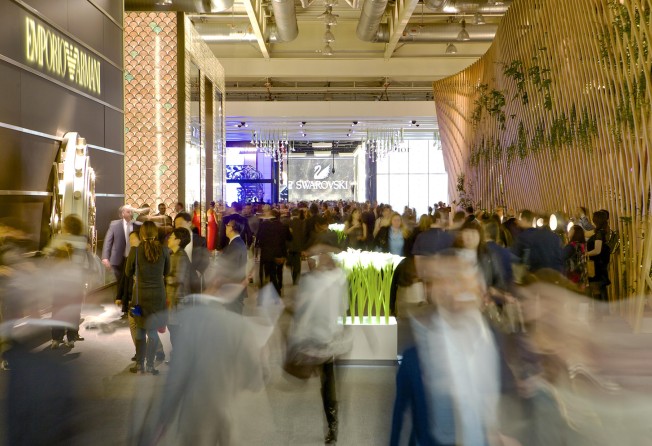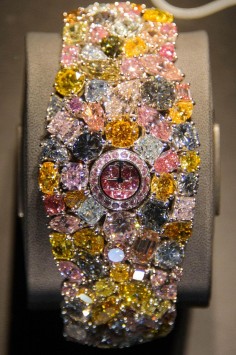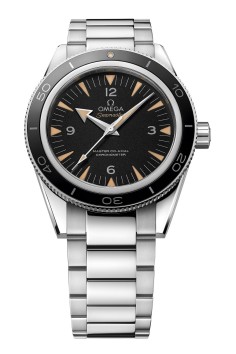
Watch designs from fashion brands steal the limelight at BaselWorld
Traditional watchmakers struggled to hold their own at BaselWorld against the big fashion houses, which are aggressively moving into the market, writes Abid Rahman

The 2014 edition of BaselWorld, the world's largest jewellery fair, attracted more journalists, retailers, collectors and members of the public than ever before. But behind the numbers it was a story of contrasting fortunes, as austerity made its presence felt, and competition from the world of fashion went up a notch.
In the internet age, where no product announcement is safe from leaks, most of the brands showing at BaselWorld released a great deal of information and pictures of their new watches before the fair officially opened. Many of the major trends had been raked over by the watch and fashion press before a single product presentation.
But the biggest story before BaselWorld opened, at least outside of the specialist watch press, was the aggressive moves made by the big fashion houses into watches and branded jewellery.
Last year, British luxury brand Burberry made its debut at BaselWorld with Swiss-made watches, and this year Emporio Armani returned to the fair after a 10-year gap with a huge facelift.
Now featuring a range of watches made in Switzerland, and sporting significantly higher prices, Emporio Armani's return and revamp encapsulated the model followed by all the major fashion brands. That is, raising the credibility of their watches and paying top dollar to make sure everyone knows about it.
Hermès, Salvatore Ferragamo, Dior, Fendi, Versace and others have come to dominate the second most important hall at BaselWorld, paying sky-high rental fees and splashing out on the most outlandish booths, to attract more attention than their narrow collections and fledgling businesses actually deserve.
The presentations by the larger watchmakers were line extensions, colour and material variations and rebirth of iconic pieces. Indeed, there was a palpable sense of holding back on completely "new" watches among the biggest names.
Spooked by the luxury goods and corruption crackdown on the mainland, and the continued malaise in European markets, Swiss watchmakers were more cautious with their releases. It was a far cry from the ebullient triumphalism of only a couple of years ago.
Rolex generated maximum attention with minimum effort, and sent Rolex aficionados the world over into social media meltdown with an update of the GMT Master II with a "Pepsi bezel". This is named for the blue and red of the patented ceramic bezel, a colour combination first released in 1955 but not seen for several years.

Omega also looked to icons from the past, such as the Speedmaster Mark II and a rebirth of the Seamaster 300.
Garrulous Omega CEO, Stephen Urquhart called the return of the Seamaster 300 his "personal passion project", and a necessary move as the iconic watch he felt "literally stank of Omega," reinforcing both its links with its glorious past, and providing the perfect foil for its new Master Co-Axial anti-magnetic movement.
Although evolution rather than revolution was the mantra at the stellar brands, there were big changes inside the main hall, Hall 1 North, as LVMH grouped its watch brands - Bulgari, Hublot, Zenith and Tag Heuer - at the main entrance.
Only LVMH's Louis Vuitton stood above the fray at an exclusive offsite villa, and it went to some expense to ferry VIPs and journalists to and from the main exhibition space.
Hamdi Chatti, vice-president of Louis Vuitton watches and jewellery, says that his brand doesn't necessarily have to be present during trade shows like BaselWorld as the company controls all of its own distribution. But, he adds, its presence is crucial for other reasons.
"You have to create new things and create new excitement," says Chatti of Louis Vuitton's watch business, which started relatively late, in 2002, and is fast gaining credibility even among the more hardened purists. This rise in fortune is helped in huge measure by its BaselWorld presentations and press outreach. Chatti also adds that the BaselWorld fair gives the Louis Vuitton watch division "rhythm, within the company" to meet production deadlines.

A watchmaking initiative that brings together the world's best watchmakers to create a limited edition concept timepiece each year, the Opus project has become one of the highlights of BaselWorld.
As Harry Winston moved downstairs to join the Swatch Group cluster, its place upstairs was taken by British jeweller Graff, which courted attention by exhibiting the most expensive watch ever at BaselWorld. The US$55 million "Hallucination" high jewellery watch featured 110 carats of coloured diamonds and signalled Graff's aggressive debut at BaselWorld.
Graff, Boucheron, Jacob & Co, Swarovski and many other jewellery focused brands have increased their watch lines as the worlds of fine watchmaking and high jewellery merge.
Independent watchmakers, the true mavericks of horology, once again created the real eye-catching and innovative pieces at BaselWorld.
MB&F created a desk clock called the "Starfleet Machine", underlining its commitment to making what founder Max Busser calls "mechanical art that tells the time".
Christophe Claret, a real rebel who bucks all industry trends, created the best watch of the entire fair, the Margot, his first ladies' watch. The petals that adorn the dial disappear one by one only to appear all at once at the push of a button.
It wasn't all watches and jewellery at BaselWorld. The circus that surrounds the event seems to get bigger and glitzier each year, more so as the fashion brands bring their particular flair to proceedings. Lunches, dinners and parties, the entertainment budgets for BaselWorld are still in an inflationary cycle.
As in previous years, watch and jewellery brands drafted in their celebrity ambassadors to rack up the hits on Instagram and Twitter as well as dazzle their retail and VIP clients.
Chopard had a helping hand from Oscar winner Colin Firth and his wife Livia, but it was football stars who took centre stage, with the World Cup on the horizon.
Many brands maximised their association with soccer, including JeanRichard, which brought in former Arsenal great Robert Pirès, Hautlence, which paraded Eric Cantona, and Hublot, which presented Jose Mourinho.
